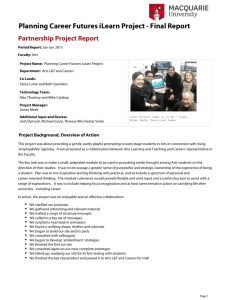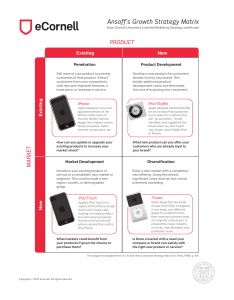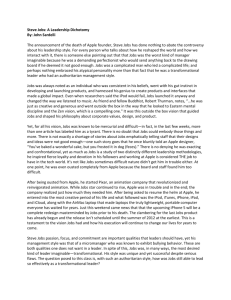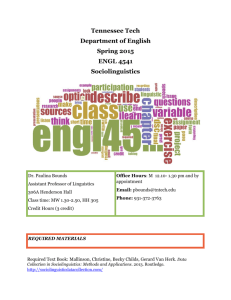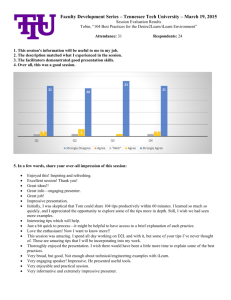Controls - Annie Drury | Public Relations and Design
advertisement
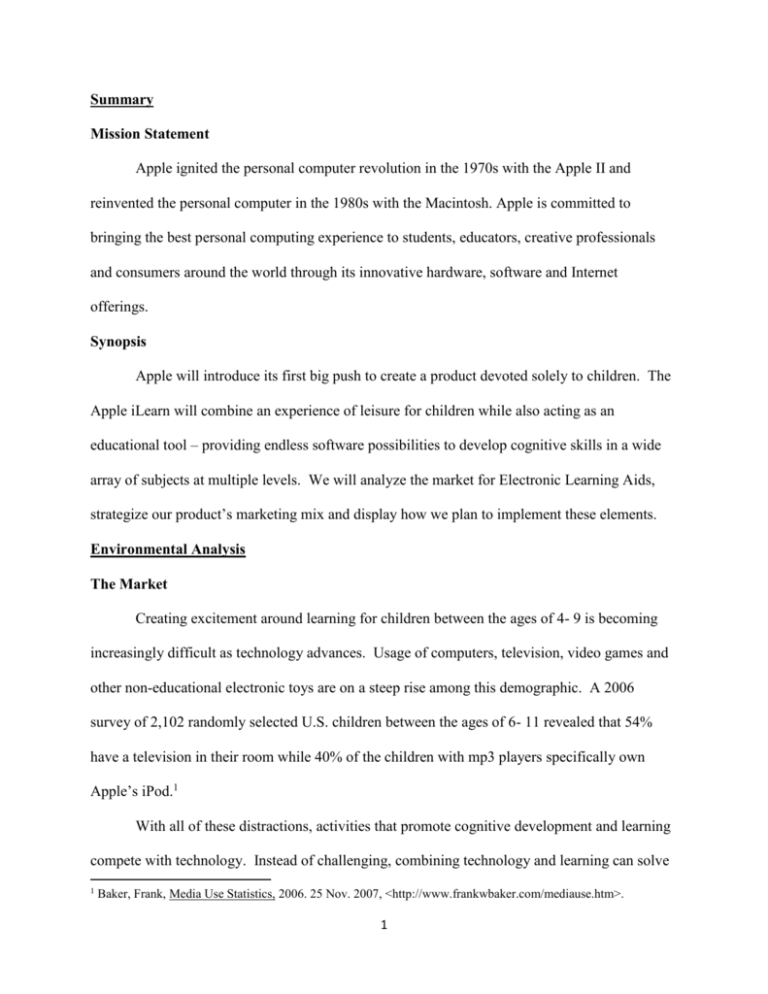
Summary Mission Statement Apple ignited the personal computer revolution in the 1970s with the Apple II and reinvented the personal computer in the 1980s with the Macintosh. Apple is committed to bringing the best personal computing experience to students, educators, creative professionals and consumers around the world through its innovative hardware, software and Internet offerings. Synopsis Apple will introduce its first big push to create a product devoted solely to children. The Apple iLearn will combine an experience of leisure for children while also acting as an educational tool – providing endless software possibilities to develop cognitive skills in a wide array of subjects at multiple levels. We will analyze the market for Electronic Learning Aids, strategize our product’s marketing mix and display how we plan to implement these elements. Environmental Analysis The Market Creating excitement around learning for children between the ages of 4- 9 is becoming increasingly difficult as technology advances. Usage of computers, television, video games and other non-educational electronic toys are on a steep rise among this demographic. A 2006 survey of 2,102 randomly selected U.S. children between the ages of 6- 11 revealed that 54% have a television in their room while 40% of the children with mp3 players specifically own Apple’s iPod.1 With all of these distractions, activities that promote cognitive development and learning compete with technology. Instead of challenging, combining technology and learning can solve 1 Baker, Frank, Media Use Statistics, 2006. 25 Nov. 2007, <http://www.frankwbaker.com/mediause.htm>. 1 this problem; enter the electronic learning aid (ELA). Pioneered by product such as speak and spell, it has evolved into the lucrative multi-million dollar market of “edutainment”. “The worldwide market for ‘edutainment’ toys reached $1.7 billion in 2005 and could total $5.5 billion by 2010, according to In- Stat, a market research firm.”2 The 2006 U.S. census reports there are approximately 22 million children between the ages of 4- 9. Since 1997 birthrates have been on the rise, recorded at 67 births to 1000 women, with significant increases among mothers over the age of 25.3 "More than 30 percent of babies born in the U.S. are to affluent moms aged 25-plus, who consider education a No. 1 priority for their children," according to Reyne Rice of the Toy Industry Association.4 The current ELA market features electronic story books, video game consoles and laptops made for a child. The market leaders are LeapFrog and V-Tech with Hasbro and Mattel’s Fisher-Price also releasing competitive products. Leapfrog’s net sales declined by 22% from 2006 to 2007.5 Meanwhile, Vtech’s net sales in North America grew by 29.2% in their electronic learning products sector.6 Analysts suggest that LeapFrog’s struggling sales can be attributed to the fact that their products feel too much like homework for children. Their competitors are taking over the market share by following industry trends and creating products resembling “big kid” handheld and tabletop electronics.7 According to Daniel Neal, chief executive of Kajeet, a cell phone company that has created a sophisticated cell phone for 2 Wall, Barbara. "Ambitious Parents Spend on Educational Toys for Toddlers," International Herald Tribune 24 Nov. 2006, 28 Nov. 2007 < http://www.iht.com/articles/2006/11/24/yourmoney/mtoys.php>. 3 “Birth and Fertility Rates,” Child Trends Databank, 28 Nov. 2007 <http://www.childtrendsdatabank.org/indicators/79BirthRates.cfm> 4 Wall. 5 “LeapFrog Quarterly Report,” LeapFrog Enterprises, Inc. 9 Nov. 2007, 25 Nov. 2007 <http://www.leapfroginvestor.com/phoenix.zhtml?c=131670&p=irol-sec> 6 “VTech Fiscal Year 2007 Report,” Vtech, 25 Nov. 2007 <http://www.vtech.com/investor_relations/reports/AR2007_eng(P1-23).pdf> 7 Hamner, Susanna, "Why the Kids Are Dissing LeapFrog," Business 2.0 Magazine 1 Nov. 2005, 25 Nov. 2007 <http://money.cnn.com/magazines/business2/business2_archive/2005/11/01/8362840/index.htm>. 2 children, "When we put devices in front of kids, if they smack of kid-ness, they're much less interested, they want your iPhone, they want your BlackBerry, and they're smart enough to use it better than you do."8 iLearn - Product Overview Electronic learning aid which will support a wide array of educational software available for download on iTunes Also supports entertainment software, plays video and audio Will have speakers and headphone capability (included) Parents can customize programs and settings to appropriate age and learning level Same structure, size and touch screen attributes as iPod Touch and the iPhone 8gb hard drive Parent password protection abilities will be available to restrict overuse of “fun” features Environmental Factors Micro – shelving space in retailers To differentiate ourselves from the competition, we will be put in the electronics and gaming sections of retailers versus the toy aisle. Thus establishing our product’s branding on a higher level of technology and sophistication. Macro – technology is growing rapidly Our competition will quickly try to innovate on the ELA market once our product is released. We must continually evaluate our market presence and make improvements to prevent competition gaining momentum over the iLearn. 8 Ritchell, Matt and Brad Stone, "For Toddlers, Toy of Choice Is High-Tech Device." New York Times 29 Nov. 2007: 28. 3 Situational (SWOT) Analysis Strengths The iLearn is easily portable and convenient. Pieces aren’t easily lost and programs are easily downloadable from a home computer. Style and function are familiar. The iLearn will resemble the iPod line, particularly the iPhone and iPod Touch. Because of favorable brand recognition and customer loyalty, customers will trust our reliability with the possibility to exceed expectations. The iLearn is priced at the same price as the current iPod nano. Because the iLearn is targeted to a different demographic than the iPod, there is no worry of cannibalization of iPod sales. Start-up costs will be minimal because of established manufacturing of iPhone and iPod Touch. Software will be more interactive than competitors especially with touch screen capability. The introduction of the Apple Product at such an early age will produce future long term customer, improving the Customer Lifetime Value (CLV) Weaknesses Collaborators may demand that we charge higher prices on iTunes than we would like. The iLearn might be too fragile for children ages 4- 9. Currently, the iPhone and iTouch are not meant to be dropped with cases available for them are mostly meant to protect from scratching. Also, we can assume that adults drop their phones less than children. However, children are shorter than adults and will have a shorter drop distance than an adult, should they drop it. The rechargeable battery has a life of approximately 18 month. After that time, the user will have to send in their iLearn to have the battery replaced. Opportunities There is possibly to make specialty iLearn products available for educators, schools and educational 4 Threats Apple’s success quickly draws competition. Continuous research of outside product development, competitive performance and constant marketing of superiority are imperative. Apple’s competitive edge requires a certain degree of secrecy within the company. Leaked product information, operational actives, or plans for the future are a major threat. Third party developers could possibly pirate software on the internet, which could possibly introduce viruses into the product or take away from our software sales. Marketing Objectives and Issues Apple expects the iLearn to become the top seller in educational learning technology industry for children ages 4-9, by the end of the 2010 fiscal year. In order to accomplish this goal, the iLearn is going to use a market-challenger strategy for direct competition. The top toy makers worldwide in 2005 included Mattel 12%, Hasbro 7%, LeapFrog 2%, and others 79%, therefore it is important that we focus on the quality of our product instead of the variety and overall toy market share that we hold.9 Prior to the launch of the iLearn, it is essential that we have games readily downloadable. Therefore, it is our goal to collaborate with game designers and companies such as Disney, Nickelodeon, and Cartoon Network to produce 50 games before the iLearn is released. In order to create successful games, we need to make licensing agreements with these companies and work with developers to create games that are both educational and engaging for kids within our target segment. Many of our competitors already have agreements with these companies so we will need to use a similar strategy for direct competition. LeapFrog currently has programs featuring Scooby-Doo, Dora the Explorer, SpongeBob SquarePants and characters from the 9 Lazich, Robert S. MarketShare Reporter 2008 Vol. 2 (Detroit: Thomson Gale, 2008) 550. 5 movies Madagascar, Finding Nemo, The Incredibles and Cars.10 These licensing agreements will require not only cost but time to insure the best interest of our collaborators. Marketing and Competitive Strategy Our unique product offering is an educational learning device that provides top of the line learning techniques, as well as a device that is fun to use and appealing to children. The current toy market trends plays a big role in our product positioning as the iLearn will be like an iPod tailored to the needs of children, providing value to both the kids who use it and their parents. We used a penetration strategy on the pricing of our product by setting it at $149. This price is reasonable based on provided features and similar features to the iPod Touch, retailing at $299. We chose to make only a small profit on the iLearn device, in order to reach more consumers and allow our product to become the market share leader in the edutainment market. However, our product is more expensive than the current competitor’s similar products by approximately $60, which distinguishes our product in its technological advancement. This price premium is well justified by the video and audio capabilities and by our strong brand equity. We will charge $15 for each game downloaded off of iTunes. This razor-razor blade strategy comes into play since only iLearn software is compatible with our product. Including royalties and licensing fees associated with the games, our costs of the games will still be low, generating a high profit margin. The iLearn will be available at major retail stores such as Target, Wal-Mart, Costco, and Toys “R” Us as well as in the Apple Store and Apple online. Apple already has distribution channels with all of these stores, except for Toys “R” Us, as other products, such as iPod, are already sold there. Our major competitors sell the majority of their products in these stores so we must too for direct competition. However, the iLearn will be sold in the electronics sections 10 “LeapFrog Quarterly Report.” 6 of these stores next to the iPods and other electronics for older children and adults because of the image that we want to promote - an iPod that looks and acts like a grown up version but is made for kids. In order to promote the iLearn, we will use two different campaigns: one for parents stressing the educational value and a separate one targeting children which highlights the fun aspects and features. This will be accomplished through advertisement and promotion on shows such as the Today Show, The Oprah Winfrey Show and magazines like Parenting which circulate to our target parent segment. Parenting magazine has an index of 205 for ages 25-34 which matches our ideal audience.11 We will separately market to children by advertising on the most popular children networks including Nickelodeon. Nickelodeon's Fairly Odd Parents, SpongeBob Squarepants and Jimmy Neutron were ranked the top 3 kid’s programs during the 2002/ 2003 season for Kids 2- 11 as well as Kids 6-11 which encompasses our age group of 4-9 years old.12 In the advertisements focused towards the children, there will be a heavier focus on entertainment value and licensed cartoon characters as opposed to the educational value. This strategy will create intrigue for the iLearn among children and their parents, because of the specific value conveyed to each. Market Action Plan Timeline December 2008: Begin research and development. Focus groups and surveys will be conducted to influence development. Estimated cost of $6 million on R&D. 11 "The Parenting Group Media Kit," The Parenting Group, Inc. 4 Dec. 2007 <http://www.parentingmediakit.com/parenting/index.html>. 12 "Nickelodeon Cable TV Advertising," Time Warner Cable Media Sales, 4 Dec. 2007 <http://www.cablemediasales.com/pages/nets/?cp=nets&sp=info&net=nick> 7 January 2009: Collaboration with Disney and Nickelodeon on games begin. Apple already has many Disney songs available on the iTunes Music Store.13 Prior licensing agreements between Apple and Disney already exist which will ease future agreements. April 2009: Apple will release the first official news release for the iLearn. May 2009: Begin advertising. To be advertised on television, magazines, and billboards. It will be advertised in children’s magazines like Nickelodean and mainstream adult magazines such as Newsweek. According to Newsweek’s media kit, Newsweek reaches 18.5 million affluent educated readers looking for intelligent information and with an edge.14 June 2009: The iLearn will appear on the Today Show. The Today Show reaches a wide range of audience aging from 25 to 54.15 The age range of the targeted parents. July 2009: The iLearn will appear on the Oprah Winfrey Show. Some of Apple products have already been featured on the Oprah show and the iPod was even named one of Oprah’s favorite things in 2005.16 Everyone in the audience of the show on a specified date will get a free iLearn to take home. August 2009: iLearn to be released at the end of the month. Based on LeapFrog’s annual report, the back to school rush and the holiday season are the most profitable seasons.17 August will set us up to still be new at these times. “Apple and Walt Disney Records Team up to Deliver Exclusive Soundtracks on iTunes,” Apple.com, 21 Apr. 2004, 3 Dec. 2007 <http://www.apple.com/pr/library/2004/apr/21disney.html>. 14 “Newsweek Media Kit,” Newsweek.com, 3 Dec. 2007 <http://www.newsweekmediakit.com/newsite/us/editions/national.shtml>. 15 Huff, Richard. 'Today Show' Still King of Morning Television,” New York Daily News, 7 Oct. 2007, 3 Dec. 2007 <http://www.nydailynews.com/entertainment >. 13 “Oprah’s favorite things Holiday 2005,” Oprah.com, 3 Dec. 2007 <http://www.oprah.com/presents/2005/holiday/gifts/gifts_oft_350_106.jhtml>. 17 “LeapFrog Annual Report” LeapFrog Enterprises, Inc. 3 Dec. 2007. < http://media.corporate-ir.net/media_files/irol/13/131670/reports/2006Annual_Report >. 16 8 Budget Explanation Development Our development cost projections are based on a few assumptions. We know that the iPhone’s development cost was $75 million.18 We assume that the iPod development cost was a third of that, or $25 million. Development Assumption Reasoning: When the iPhone launched, it was among the first smart phones and by far the most expensive. This required extensive marketing. When the iPod first launched, it was not the first mp3 player. Furthermore, when the iPod first launched, it was poorly marketed, but overtime the product created its own hype and its popularity grew exponentially. The iPod ended up being a desirable product to a wide array of demographics.19 The iPhone had a much smaller demographic and required a successful a launch. The next assumption is that the iLearn’s development cost will be 20% compared to the iPod ($5 million). This is because the iLearn will not be new technology (actually a downgrade from the iPhone). It will not be considered a revolutionary product in design because the iPhone has already launched, and it has a far smaller market demographic than the iPod. [See Budget: Assumptions] Financing As previously explained, the iLearn will require $5 million in development cost. This includes Start-up and marketing costs. An additional $1 million will be necessary to cover initial 18 "Apple Inc. Form 10-K," EDGAR, 12 Nov. 2007 <http://yahoo.brand.edgar-online.com/fetchFilingFrameset.aspx?dcn=0001047469-07-009340&Type=HTML>. 19 Lloyd, Dennis, “Instant Expert: a Brief History of IPod," ILounge, 26 Jun. 2004, 12 Nov. 7 <http://ilounge.com/index.php/articles/comments/instant-expert-a-brief-history-of-ipod/>. 9 projected operating costs until sufficient revenues are generated. This will cover three months’ worth of expenses at approximately $300,000 a month (as shown in the 1 year Pro Forma). Therefore, the total capital cost will be $6,000,000. We assume that the capital costs will be borrowed and amortized over 5 years at 7% interest. On the 1 Year Pro Forma, we assume Apple will put up cash to cover development costs and interest until launch. Under this assumption, monthly finance costs, beginning at launch, will be $118,117. This will generate a total payback of $7,128,420, $1,128,431 of that in interest Revenue and Growth The assumption is that the iLearn will be 20% of the iPod in number of units sold.20 The reason is that there is a more select customer base. The iPod has a potential market of the entire population, whereas the iLearn’s market base is the 4-9 year old age group and their parents. By selling the iLearn at $149, we are able to determine iLearn sales. Furthermore, historically iPod sales split almost evenly between foreign and domestic. We predict the same for the iLearn. [See Budget: Assumptions] Cost of Goods and Pricing Our cost of goods is measured by taking the individual component costs required to make an iPhone and deducting the costs not necessary to make an iLearn.21 In the end, we are left with the production cost of an iLearn. Our goal is to price the item as low as possible. We are reluctant to exceed $149 for the iLearn because we can’t expect the kids or parents to pay the $399 they are willing to pay for an iPhone. Our determined price and our calculated costs yield a COG of 75%. [See Budget: Cost of iPhone; Cost of iLearn] “Apple Inc. Form 10-K.” Marsal, Katie, "Apple May See 50 Percent Margin on Each IPhone Sale," Apple Insider, 18 Jan. 2007, 12 Nov. 2007 <http://www.appleinsider.com/articles/07/01/18/apple_may_see_50_percent_margin_on_each_iphone_sale.html>. 20 21 10 Expenses Payroll: Payroll was determined by finding the salaries and wages of the required people to develop and sell the iLearn.22 The number of required employees was derived from what was needed to build a similar product, the Palm Pilot.23 Their wages were determined by Salary.com and accounted for. [See Budget: Assumptions] Marketing Expense: We know what the iPods sales were for 2005, 2006, and 2007.24 We also know how much advertizing Apple spent on the iPod for 2005, 2006, and 2007. To find the advertising expense required for the iLearn, we found the percent of sales that was spent on advertising for the iPod and applied that percentage to the projected sales of the iLearn. This percentage was roughly 2% each year from 2005-2007. [See Budget: Assumptions] General and Administrative Expense (G&A): Because we know the iPod’s sales and G&A 20052007, we can determine what percentage of iPod sales is G&A.25 We then applied that percentage to the iLearn’s projected sales. The iPod percentage was roughly 12 to 13% each year from 2005-2007. We reduced this to 10% for the iLearn because there will be less G&A than the iPod. [See Budget: Assumption] Ratios To complete the financial section, we looked at two ratios, Return on Investment (ROI) and Times Interest Earned (TIE). We calculated ROI on an annual basis, by dividing each month’s net cash by the $6 million investment. ROI increased each year as sales increased, although it remains negative until year five. [See Projected iLearn Annual ROI; TIE] 22 "Know Your Worth," Salary.com, 12 Nov. 2007 <http://swz.salary.com/>. "History of Palm," Palm Loyal, Jun. 2004, 12 Nov. 2007 < <http://www.palmloyal.com/addons.php?name=News&file=article&sid=1672>. 24 “Apple Inc. Form 10-K.” 25 Ibid. 23 11 Conclusion The five year Pro Forma shows that we will little more than break even over five years. Our profit will come from the sales of the programs to those who have purchased the iLearn. We conservatively estimate that each sale of an iLearn will be accompanied by two program sales at $15 each. There will also be additional expenses associated with these programs. [See Budget: 5 Year Programs] The following table shows the combined annual earnings of the iLearn and its programs, and the ROI for each year. [See Combined Earnings and ROI for iLearn and Program Sales] Controls Implementation is key in a successful marketing strategy. We will continue to evaluate the ELA market and work on becoming a leader in the industry. There will always be new technological advances, which will affect this market. The iLearn’s market plan will be flexible and constantly reviewed for change, so the iLearn will remain most advanced electronic learning device on the market. We will continually conduct surveys and hold focus groups to determine how consumers – both parents and children - are reacting to the iLearn. Suggestions about the iLearn via the Apple website will also be taken into consideration. Apple employees will also be trained on showing children and parents how to use the iLearn. Collaborating retailers will also be supplied with information that will educate their employees. A one-year warranty will come standard and with help available at the Genius Bar at Apple stores. 12 Works Cited “Apple and Walt Disney Records Team up to Deliver Exclusive Soundtracks on iTunes.” Apple.com. 21 April 2004. 3 December 2007 <http://www.apple.com/pr/library/2004/apr/21disney.html>. "Apple Inc. Form 10-K." EDGAR. 12 Nov. 2007. <http://yahoo.brand.edgar-online.com/fetchFilingFrameset.aspx?dcn=0001047469-07009340&Type=HTML>. Baker, Frank. Media Use Statistics. 2006. 25 Nov. 2007 <http://www.frankwbaker.com/mediause.htm>. “Birth and Fertility Rates.” Child Trends Databank. 2005. 28 Nov. 2007. <http://www.childtrendsdatabank.org/indicators/79BirthRates.cfm>. Hamner, Susanna. "Why the Kids Are Dissing LeapFrog." Business 2.0 Magazine. 1 Nov. 2005. 25 Nov. 2007. <http://money.cnn.com/magazines/business2/business2_archive/2005/11/01/8362840/index.htm> "History of Palm." Palm Loyal. June 2004. 12 Nov. 2007 < http://www.palmloyal.com/addons.php?name=News&file=article&sid=1672 >. Huff, Richard. 'Today Show' still king of morning television.” nydailynews.com. 7 October 2007. 3 December 2007. <http://www.nydailynews.com/entertainment >. "iPod Time Line." Wikipedia. 11 Nov. 2007. 12 Nov. 2007 <http://en.wikipedia.org/wiki/IPod#Timeline_of_iPod_models >. "Know Your Worth." Salary.com. 2007. 12 Nov. 2007 <http://swz.salary.com/>. Lazich, Robert S., 2ed. MarketShare Reporter 2008. Vol. 2. Detroit: Thomson Gale, 2007. “LeapFrog Quarterly Report.” LeapFrog Enterprises, Inc. 9 Nov. 2007. 25 Nov. 2007. <http://www.leapfroginvestor.com/phoenix.zhtml?c=131670&p=irol-sec> Lloyd, Dennis. “Instant Expert: a Brief History of IPod." ILounge. 26 June 2004. 12 Nov. 2007. <http://ilounge.com/index.php/articles/comments/instant-expert-a-brief-history-of-ipod/>. Marsal, Katie. "Apple May See 50 Percent Margin on Each IPhone Sale." Apple Insider. 18 Jan. 2007. 12 Nov. 2007. <http://www.appleinsider.com/articles/07/01/18/apple_may_see_50_percent_margin_on_ each_iphone_sale.html>. 13 Newsweek Media Kit. Newsweek.com. 3 Dec. 2007. <http://www.newsweekmediakit.com/newsite/us/editions/national.shtml> "Nickelodeon Cable TV Advertising." Time Warner Cable Media Sales. 4 Dec. 2007 <http://www.cablemediasales.com/pages/nets/?cp=nets&sp=info&net=nick> “Oprah’s favorite things Holiday 2005.” Oprah.com. 3 December 2007. <http://www.oprah.com/presents/2005/holiday/gifts/gifts_oft_350_106.jhtml> "The Parenting Group Media Kit." The Parenting Group, Inc. 2007. 4 Dec. 2007 <http://www.parentingmediakit.com/parenting/index.html>. Ritchell, Matt and Brad Stone. "For Toddlers, Toy of Choice Is High-Tech Device." New York Times. 29 Nov. 2007: 28. “VTech Fiscal Year 2007 Report,” Vtech, 25 Nov. 2007. <http://www.vtech.com/investor_relations/reports/AR2007_eng(P1-23).pdf>. Wall, Barbara. "Ambitious Parents Spend on Educational Toys for Toddlers." International Herald Tribune. 24 November 2006. <http://www.iht.com/articles/2006/11/24/yourmoney/mtoys.php>. 14

